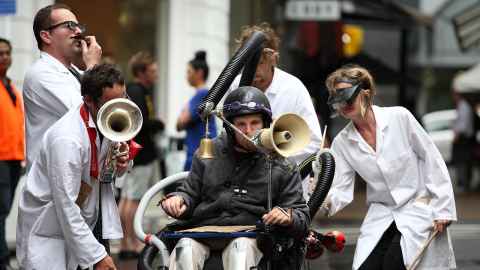Breaking down barriers for disabled musicians
1 July 2023
Instruments are out of tune with the needs of disabled musicians. PhD candidate Drew McMillan wants that to change.

A life-changing accident in 2004 left Drew McMillan paralysed with tetraplegia from the chest down, dramatically affecting his music career.
He was attempting to perform a trick on his bike at a friend’s place, as he had done numerous times before, when he landed the wrong way.
“I slowly opened my eyes knowing that what had just happened was definitely not good. There, in front of me, were a pair of feet. I recognised them as mine, but I could not feel them as mine. They had my shoes, my jeans, but felt detached, as if they were someone else’s.
“I slowly came to realise, this was what having spinal shock was.”
Before the accident, the talented musician was part way through an honours degree in composition.
He regularly performed gigs and was an accomplished saxophone, flute, clarinet and piano player – as well as an electronic musician and composer.
Drew has gone on to achieve a great deal of success. He returned to the University of Auckland to finish his degree and went on to complete his masters in composition and interactive technologies.
Now in the second year of his PhD at the School of Music, Drew is using his own experience to explore how to design bespoke instruments for musicians with disabilities.
In collaboration with his supervisors at the School of Music, Fabio Morreale and John Coulter, Drew’s research is focused on addressing the relationship between disabled musicians and their instruments, and how this experience can be incorporated into the design process.
“I am hoping to discover a way to construct an instrument that enhances my musician-instrument relationship in a way that is similar to what it was before my accident. The nuances, and the connection with instruments that I’m currently using, doesn’t give me a satisfactory musician-instrument relationship to be as creative as I would like, either on my own or when collaborating,” says Drew.
A lot of the designing of instruments for people with disabilities is done by able-bodied people working on participatory design methods. These frameworks work reasonably well and are based on the idea of assessing what the musician wants to do and what their goals are, says Drew.
“However, because I have a relationship with my instruments from before the accident as well as after it, I feel like there is a gap in the framework. I wanted to find a way of diving deeper into assessing the relationship that people want with their instrument.”
Because I have a relationship with my instruments from before the accident as well as after it, I feel like there is a gap in the framework. I wanted to find a way of diving deeper into assessing the relationship that people want with their instrument.
The idea for Drew’s research came a few years after his accident when he started to look into ways he could perform and compose music again.
In early performances, he used a laptop, webcam and microphone to make and control sounds.
In 2019, he started playing the guitar by placing it on a custom-made case that converts into a stand that sits horizontally across his lap. He processed the guitar signal through a distortion pedal and a volume pedal, which enabled him to perform in an ensemble with a bass player and a drummer, playing rock-influenced free improvisations.
While playing, he uses two splints attached to his hands. One for picking and strumming, and the other for placing a slide on the strings, which enables him to produce a range of different sounds.
“Playing again has helped me to establish a relationship with music that is pushing me towards discovering more rewarding ways to create and collaborate,” says Drew.
“But playing is still a challenge that provides a series of complex problems that I need solve through my research. Hopefully by doing that, I can discover that connection again.”
By Hussein Moses
This story first appeared in the July 2023 edition of UniNews.